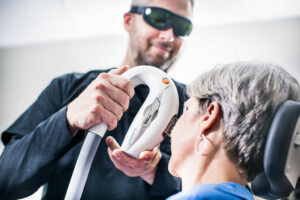
Dr. Dierker is conducting an intense pulsed light (IPL) treatment on a patient using the M22 from Lumenis. IPL can be a significant investment, but Dr. Dierker says there are many ways to build a dry eye center on a budget.
Building a substantial dry eye practice without breaking the bank.
By Damon Dierker, OD, FAAO
Feb. 14, 2024
The most frequent medical reason a patient visits an optometrist or ophthalmologist is to address dry eye.
The DEWS II Epidemiology Report estimated the global prevalence of dry eye disease (DED) at 5 – 50 percent, and the National Eye Institute reports that almost 16 million Americans have DED. As eyecare providers, we must embrace this prevalence and establish a way to diagnose and treat the disease.
Dry eye treatment can be set up with minimal investment, and it can lead to a significant revenue stream for your practice. About 40 percent of my patient visits are specifically for DED, and they make up approximately 70 percent of the revenue earned in my clinic.
Our DED center has been growing 20 – 30 percent year over year since 2014. I typically see approximately 300 patients each month with DED as the primary reason for their visit, and many other patients have DED as a secondary complaint. Every year, I diagnose about 1,000 new patients with DED. We’ve added a DED-focused doctor in the past year to help meet the ongoing demand.
Diagnosing and treating DED improves care, builds trust, improves surgical outcomes and provides opportunity for significant revenue generation. My practice earns several hundred thousand dollars per year from in-office DED treatments such as thermal expression and light-based therapies (intense pulsed light and low level light therapy). These treatments help address root causes of DED, meibomian gland obstruction and inflammatory lid margin disease, which are found in the majority of our patients.
Small Investment, Big Results
I can screen for DED with an investment of about 50 cents for a printed questionnaire and a strip of fluorescein dye. Each new patient is given a validated dry eye questionnaire to fill out at check-in, and I then use the dye before slit lamp examination to assess tear meniscus height, tear breakup time and ocular surface staining. I also perform a meibomian gland expression as part of their screening
These simple steps provide important information. A further step I take in my practice is to add point-of-care diagnostics, including tear osmolarity testing and testing for inflammation. I utilize ScoutPro (Trukera Medical) to assess tear osmolarity in patients with any sign or symptoms to suggest DED. I also use InflammaDry (QuidelOrtho) to test for elevated MMP-9 levels when patients present for a dedicated DED visit.
Finally, I use meibography to image the meibomian glands (LipiScan, Johnson & Johnson Vision Care). These technologies require some investment, but for less than five figures, they help you to refine your diagnosis, educate the patient more effectively and monitor change over time.
There are additional technologies at a higher price point that may be a good choice for some practices, but for others, they may not provide a cost benefit. Unless you have the basics in place to be able to serve your patients with a low-to-medium level of technology, it is unlikely you’ll be effective with a high technology investment.
Other Articles to Explore
Treatment Recommendations
In addition to in-house procedures and the prescription of pharmaceuticals, there are many small actions that can have a positive influence on a DED patient’s quality of life. This can include recommendations around taking breaks when you’re on a computer, setting up your workstation correctly, not sleeping with a fan on, or using a particular type of lubricant drop in specific situations.
OTC products also play an important role in comprehensive patient care. I recommend over-the-counter (OTC) products to my patients and make sure that acquiring them and continuing to refill them is easy. It is important to recommend specific products; I look for high-quality products that are affordable, well-packaged, easy to administer and readily available for patients to access either in our office or online.
If I find a quality product line that provides good value, I usually don’t see a strong reason to choose a different manufacturer for each product. I use Optase, for example, as a source for drops, masks and lid scrubs. I also tell my patients about Zocular lid scrubs and iVizia lubricants and gels. We carry about 10-12 products at all of our office locations for patients to purchase.
I recommend HydroEye (ScienceBased Health) as my go-to nutraceutical for DED. The supplement combats inflammation through multiple pathways and was found to be effective by a double-blind, randomized, multi-center, controlled trial. My patients who use it often report a reduction in symptoms, and I find it to be well-tolerated and affordable.
It is important to make OTC products easy for your patients to access. In our practice, we obtain products from Dryeye Rescue, which does not require that we make large orders or keep a specific quantity in stock. I can buy five bottles or 500 bottles, depending on our inventory needs. The company also provides a discount code that I can give my patients to use for orders on the Dryeye Rescue website. Our practice then receives a commission from those sales; not as high as if we were to sell the products ourselves, but significant enough to generate a few thousand dollars per month in additional passive revenue.
I generally encourage patients to obtain products I’ve prescribed from our office at their first visit and then have them use the discount code to get the refills if this is more convenient than returning to our office in between visits. We usually sell products slightly below manufacturer’s suggested retail price, but if you wanted OTC products to be a more significant part of your revenue, you could create larger margins and also encourage patients to buy enough to cover their needs until their next visit. I prefer to try to make it as easy as possible for patients to obtain the specific products I’ve recommended.
Broad Benefits
If you start small as you build up a dry eye practice, you will begin to understand the tools available to diagnose and manage patients. You don’t need to make large five or six figure investments from the jump to start a dry eye center. You can take incremental steps to build at a pace that’s comfortable for you.
As you provide solutions and take patients’ DED symptoms seriously, it will result in fewer patients discontinuing contact lenses year over year. You will have fewer remakes in your optical because you’re addressing the root problem that’s actually causing the fluctuating and blurry vision.
You will often have a better patient experience and better surgical outcomes with cataract or LASIK surgery. If patients’ ocular surface disease is under control, you’ll see better adherence to glaucoma therapies and better success managing intraocular pressure. The ocular surface influences almost everything we do, which is why I screen for signs and symptoms of disease in every single patient. It makes solid medical sense, and it provides a significant revenue stream for my practice.
 Damon Dierker, OD, FAAO, is a partner with Eye Surgeons of Indiana, an OD-MD practice. He serves as Chief Medical Advisor of Optometry for Trukera Medical, and is a consultant for ScienceBased Health, Optase, Thea Pharmaceuticals and QuidelOrtho. To contact him: damon.dierker@esi-in.com
Damon Dierker, OD, FAAO, is a partner with Eye Surgeons of Indiana, an OD-MD practice. He serves as Chief Medical Advisor of Optometry for Trukera Medical, and is a consultant for ScienceBased Health, Optase, Thea Pharmaceuticals and QuidelOrtho. To contact him: damon.dierker@esi-in.com

























